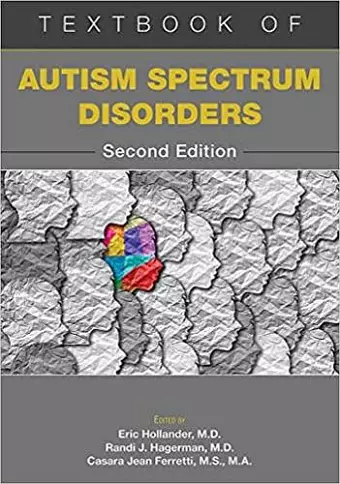Textbook of Autism Spectrum Disorders
Eric Hollander editor Randi J Hagerman editor Casara Ferretti editor
Format:Hardback
Publisher:American Psychiatric Association Publishing
Published:14th May '22
Should be back in stock very soon

More than 40 years after the official recognition of infantile autism in DSM-III, numerous questions remain about autism spectrum disorder (ASD)—its possible causes, assessment, and most effective treatments.
This second edition of the Textbook of Autism Spectrum Disorders features contributions from dozens of experts as it reviews the latest research on these topics and more.
As ambitious in scope and exhaustive as the preceding edition, this guide is organized by sections that tackle:
• Assessment and evaluation, including recognizing the lower- and higher-order repetitive behaviors characteristic of ASD, as well as its comorbidities. Chapters also discuss the roles that racial and ethnic disparities, gender and sexual identities,and biomarkers and technology—including smart home devices and augmented reality technology—can play in assessment and evaluation.
• The possible causes of autism, from prenatal, perinatal, and parental risk factors to syndromic causes of ASD, updates on genetic testing, and the effect of environmental factors and immune dysregulation.
• Standard and experimental treatments in autism. Chapters analyze the role of pharmacotherapies such as serotonergic antidepressants, atypical antipsychotics, and experimental therapeutics (e.g., oxytocin, vasopressin) as well as the use of cannabis, cannabinoids, and immunomodulatory agents. The book also examines behavioral treatments, interventions in schools, complementary and integrative medicine approaches, stem cell and gene therapies, and more.
• Social policy issues, including the role of patient advocacy groups in treatment development and an examination of autism strengths and the growing emphasis on recognizing neurodiversity.
Unrivaled in its thoroughness, the book includes summary points in each chapter for ease of reference and lists of recommended readings that offer readers the opportunity for further study and exploration. For all those in the ASD continuum of care—psychiatrists, psychologists, neurologists, social workers, speech therapists, educators, and patient families—this is an essential resource.
The text goes beyond a just-the-facts listing of research findings to consider public health and ethical considerations of assessment, treatment, and even conceptualization of ASD. The depth of coverage provided to comorbidities and syndromic causes and the emerging role of the research being led by individuals with ASD was excellent. The authors address each major chapter with statements supported by ample current research, presented in a detail-rich but digestible overview of design and findings. This textbook is unlike any other I have seen, and makes fascinating reading for the ASD professional, regardless of years of experience.
In summary, the strengths of this textbook include its breadth and depth of coverage, and the massive number of research studies presented to support the body of the chapters.
This text is very comprehensive, yet written in a reader-friendly format that would support most professionals or preprofessional students. I would recommend it for all practitioners-in-training or practices that support individuals with ASD.
ISBN: 9781615373048
Dimensions: 254mm x 178mm x 41mm
Weight: 1964g
742 pages
Second Edition